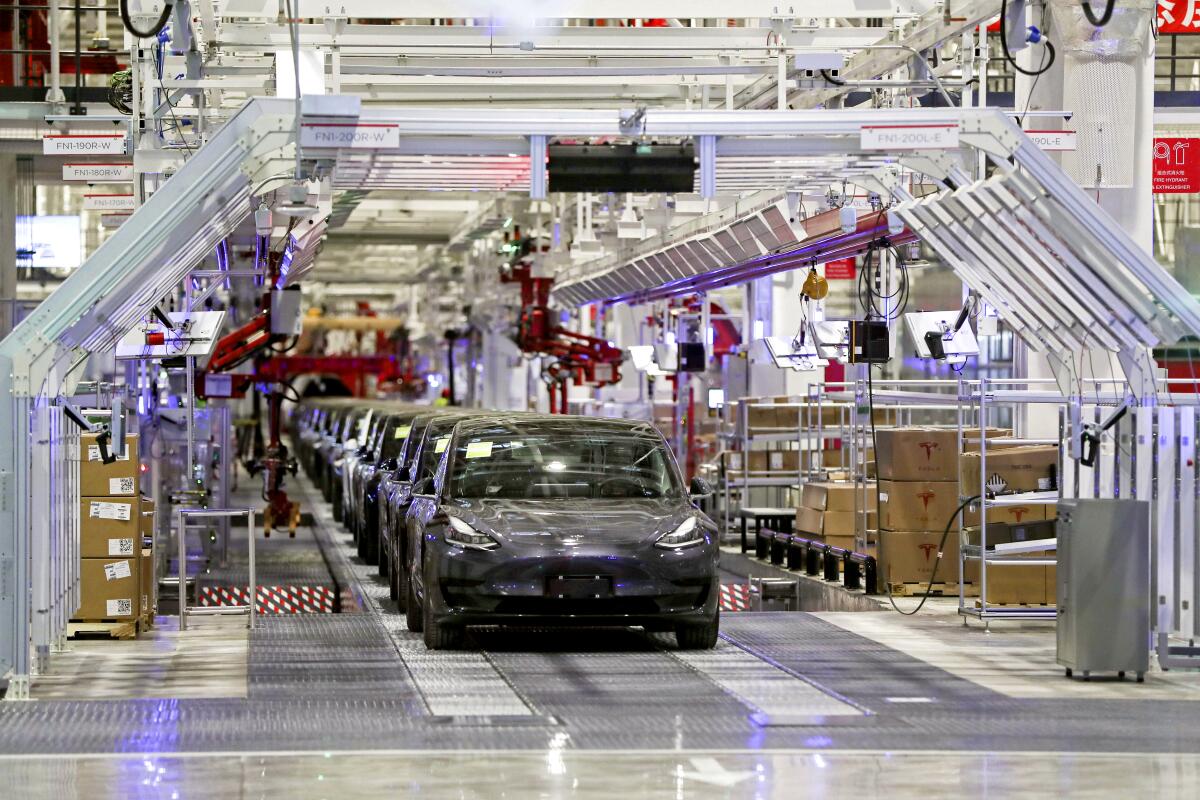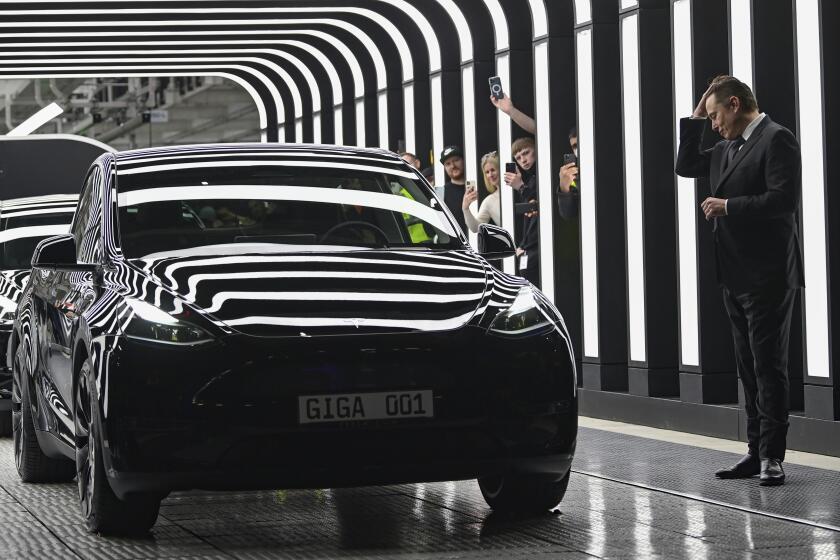Opinion: To meet climate goals, China needs to phase in electric vehicles much faster

- Share via
As a maturing, cost-effective technology, electric vehicles are a key part of the solution to planet-heating emissions. When paired with clean electricity, they offer a route to climate-neutral ground transportation. And fortunately, electricity is getting cleaner with each passing year, owing to the rapidly falling costs of solar and wind power.
Global electric vehicle sales boomed last year, rising to 13% of all new vehicles sold, up from 8.6% in 2021. Much of this growth came from China, where sales doubled in 2022, to 6.9 million (26% of all new car sales), and showed no signs of stopping. China’s Assn. of Automobile Manufacturers forecasts that the country’s sales will grow by more than 30% in 2023, reaching 9 million (33% of total new vehicle sales).
It’s a beautiful car with no carbon emission, and initially, I was proud of owning it and being seen driving a vehicle that displayed my concern for the environment.
But not even this rate of growth will be enough to uphold China’s or the world’s climate commitments. Carbon emissions from China’s motor vehicles alone are greater than the carbon emissions from California’s economy as a whole. To bring transportation emissions in line with scientific targets for a safe climate, China’s leaders will need to accelerate the switch to electrics.
According to the International Council for Clean Transportation, a key element in China’s success so far is its new-energy-vehicle-sales standard, a little-known policy that sets sales targets for domestic auto manufacturers. These targets will ramp up, allowing for flexible compliance through carbon-credit trading. If a manufacturer sells more than the industry average target, they receive credits that can be sold to a manufacturer that sells less. Since the policy went into effect in 2019, the benchmark has risen from 10% of all sales that year to 18% in 2023. But since sales already far exceeded that threshold last year, China’s Ministry of Industry and Information Technology can — and must — set targets much higher.
Nearly 1 in 5 new car sales in California were zero-emission in 2022, but most of them are Teslas and other high-end models. That shows how far the state has to go in making the shift to electric vehicles equitable.
Specifically, Chinese transportation officials should plan for a new-energy-vehicle standard that achieves 75% of all sales by 2030. When paired with other feasible ambitious measures for heavy-duty commercial vehicles, this would cut auto emissions 70% below 2020 levels by 2050. In contrast, vehicle emissions are forecast to rise by 63% by midcentury without additional action.
Chinese authorities have no good reason to hold back. After all, getting more clean cars on the road would also save tens of thousands of lives annually by reducing air pollution. Ambitious new-energy-vehicle standards are also essential to align China’s transportation sector with its broader net-zero emissions commitment.
Replacing one kind of car for another isn’t enough if cities like Los Angeles want to be anything other than traffic-choked dystopias.
The International Energy Agency’s modeling shows that global electric vehicle adoption must surpass 60% of all cars by 2030 to achieve net-zero emissions globally by 2050. In practice, this means that the largest, most advanced car markets must exceed the global average, because many other countries will not have the means to achieve as rapid a transition. A Chinese decision to raise its new-energy-vehicle standard to 75% by 2030 thus would be highly consequential.
A faster transition is feasible and affordable. Many electric vehicles are already available in major markets, and new ones are steadily being added to manufacturers’ product lines. Growing investment shows that automakers are serious about accelerating the shift to electric vehicles. Prices will keep falling with improvements in battery technology and economies of scale. Electric vehicles in China are already cheaper than internal-combustion cars over the life of the vehicle (after accounting for the fuel and maintenance savings that electric vehicles offer). These developments have pushed electric vehicle sales past a tipping point in China and 18 other countries, including the United States. Major markets have entered a phase of mass adoption in which preferences will shift surprisingly quickly.
Electric vehicles are still vehicles: They pollute, they kill, and they distort cities to accommodate cars instead of people.
Still, it would be a mistake to leave matters to the invisible hand of the market. Without policy changes, the transition will be slower than we need, given the lifespan of a typical car and the decades’ worth of investment that has gone into fossil-fuel infrastructure. While around 25 million new passenger cars are sold in China annually, more than 200 million vehicles are already on the road, and most will be driven for years to come.
To overcome this inertia, ambitious new-energy-vehicle-sales standards must be embedded within a broader set of strategic policies. For example, scaling up mass adoption will require measures to spur and coordinate investment in charging infrastructure. And to capture the full climate and public-health benefits of electric vehicles, greater deployment must be paired with an accelerated transition to clean electricity.
The remarkable sales growth in recent years is promising for the global fight against climate change. But transportation officials must continue to move quickly to adapt policies to global needs. While too little ambition risks unsustainable climate damage, a swift transition is essential to achieve a safe climate and cleaner air. There is no time for delay. China’s leaders must put the pedal to the metal.
Chris Busch is the director of transportation and a senior economist at Energy Innovation, an energy and climate policy research firm in San Francisco.
More to Read
A cure for the common opinion
Get thought-provoking perspectives with our weekly newsletter.
You may occasionally receive promotional content from the Los Angeles Times.













